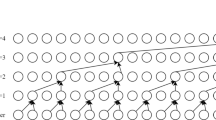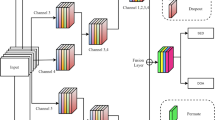Abstract
In this paper, we propose acombined variable-rate code-excited linearly predictive (QCELP)speech coding and unequal error protection (UEP) channel codingsystem for wireless communications. In contrast to theconventional schemes, our system employs a concatenatedsuper-imposed rate-compatible punctured convolutional (SI-RCPC)channel coding scheme which can provide UEP with respect to notonly the bit-significance of speech packets but also the speechactivity and local channel characteristics. Verified by thesimulation results, the combined system achieves an averagetransmission rate less than 8 kb/s as well as an average 2 dBsignal-to-noise ratio (SNR) gain over the conventional equal errorprotection system.
Similar content being viewed by others
References
F.I. Alajaji, N.C. Phamdo and T.E. Fuja, “Channel Codes that Exploit the Residual Redundancy in CELPEncoded Speech”, IEEE Trans. Speech Audio Processing, Vol. 4, pp. 325–336, 1996.
M. Schroeder and B. Atal, “Code-Excited Linear Prediction (CELP): High-Quality at Very Lowbit Rates”, in Proc. IEEE Int. Conf. Acoust., Speech, Signal Processing, April 1985, pp. 937–940.
J.H. Chen, R.V. Cox, Y.C. Lin, N. Jayant and M.J. Melchner, “A Low-Delay CELP Coder for the CCITT 16 Kb/s Speech Coding Standard”, IEEE J. Select. Areas Commun., Vol. 5, pp. 858–865, 1992.
P. Vary, K. Hellwing, R. Hofmann, R. Sluyter, C. Galand and M. Rosso, “Speech Codec for the European Mobile Radio System”, in Proc. IEEE Int. Conf. Acoust., Speech, Signal Processing, April 1988, pp. 227–230.
I.A. Gerson and M.A. Jasiuk, “Vecter Sum Excited Linear Prediction (VSELP) Speech Coding at 8 Kps”, in Proc. IEEE Int. Conf. Acoust., Speech, Signal Processing, April 1990, pp. 461–464.
D. Griffin and J. Lim, “Multiband Excited Vocoder”, IEEE Trans. Acoust., Speech, Signal Processing, Vol. 8, pp. 1223–1235, 1988.
R. Mcaulay and T.F. Quartieri, “Multirate Sinusoidal Transform Coding at Rates from 2.4 to 8 Kb/s”, in Proc. IEEE Int. Conf. Acoust., Speech, Signal Processing, Dallas, TX, April 1987.
W. Gardner, P. Jacobs and C. Lee, “QCELP: A Variable Rate Speech Coder for CDMA Digital Cellular”, in B.S. Atal, V. Cuperman and A. Gersho (eds), Speech and Audio Coding for Wireless and Network Applications, Kluwer Academic Publishers: Norwell, MA, pp. 85–92, 1993.
J.H. Park and Y.M. Kim, “Analysis and Optimization of Speech Coder Algorithm for CDMA Digital Cellular”, in Proc. IEEE Int. Conf. Commun, New Orleans, LA, May 1994, pp. 870–874.
Speech Service Option Standard for Wideband Spread Spectrum Digital Cellular System, TIA/EIA Interim Standard IS-96, April 1994.
J. Hagenauer, “Rate-Compatible Punctured Convolutional Codes (RCPC Codes) and Their Applications”, IEEE Trans. Commun., Vol. 32, pp. 389–400, 1988.
M. Hattori and Y. Saitoh “Superimposed Codes Based on Punctured Convolutional Codes”, Electron. Lett., Vol. 31, pp. 1041–1042, 1994.
J.F. Cheng and R.J. McEliece, “Superimposed Convolutional Codes”, in Proc. Int. Symp. on Commun., Taipei, Taiwan, June 1995, pp. 105–110.
X.A. Wang and S.B. Wicker, “A Soft-Output Decoding Algorithm for Concatenated Systems”, IEEE Trans. Inform. Theory, Vol. 42, pp. 543–553, 1996.
J. Hagenauer, “Source-Controlled Channel Decoding”, IEEE Trans. Commun., Vol. 43, pp. 2449–2457, 1995.
J.R. Deller, J.G. Proakis and J.H.L. Hansen, Discrete-Time Processing of Speech Signals, Macmillan Publishing Company: New York, 1993.
L. Rabiner and B.H. Juang, Fundamentals of Speech Recognition, Prentice Hall: Englewood Cliffs, NJ, 1993.
P. Lupini, N.B. Cox and V. Cuperman, “A Multimode Variable Rate CELP Coder Based on Frame Classification”, in Proc. IEEE Int. Conf. Acoust., Speech, Signal Processing, April 1993, pp. 406–409.
H. Shi, P.K.M. Ho and V. Cuperman, “Combined Speech and Channel Coding for Mobile Radio Communications”, IEEE Trans. Veh. Tech., Vol. 43, pp. 1078–1087, 1994.
E. Yuen, P. Ho and V. Cuperman, “Variable Rate Speech and Channel Coding for Mobil Communication”, in Proc. IEEE 44th Veh. Technol. Conf., Stockholm, Sweden, June 1994, pp. 1709–1713.
R.V. Cox, J. Hagenauer, N. Seshadri and C.E.W. Sundberg, “Subband Speech Coding and Matched Convolutional Channel Coding forMobile Radio Channels”, IEEE Trans. Signal Processing, Vol. 39, pp. 1717–1731, 1991.
E.P. Rathgeb, “Policing Mechanisms for ATM Networks–Modelling and Performance Comparision”, in Proceedings of 7th International Teletraffic Congress Seminar on Broadband Technologies: Architectures,Applications, Control and Performance, Morristown, NJ, 1990, paper 10.1.
M. Plotkin, “Binary Codes with Specified Minimum Distance”, IEEE Trans. Inform. Theory, Vol. IT-6, pp. 445–450, 1960.
C.-H. Wang and C.-C. Chao, “Modified SOVA Decoding for Turbo Codes”, in Proc. 1998 Int. Symp. Inform. Theory and Its Applications, Mexico City, Mexico, June 1998, pp. 643–646.
L.R. Bahl, J. Cocke, F. Jelinek and J. Raviv, “Optimal Decoding of Linear Codes for Minimizing Symbol Error Rate”, IEEE Trans. Inform. Theory, Vol. IT-20, pp. 284–287, 1973.
Author information
Authors and Affiliations
Rights and permissions
About this article
Cite this article
Wang, CH., Chao, CC. Combined Speech and Channel Coding for Wireless Communications. Wireless Personal Communications 17, 21–43 (2001). https://doi.org/10.1023/A:1008949017481
Issue Date:
DOI: https://doi.org/10.1023/A:1008949017481




